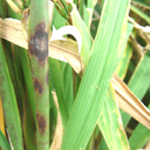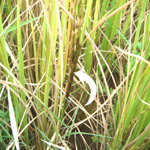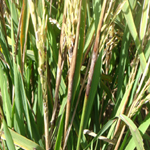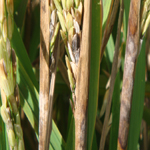|
Sheath Rot
(Sarocladium oryzae)
| |
Identification of pathogen |
|
|
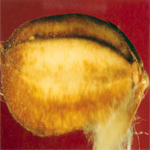 |
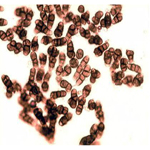 |
- The fungus produces white mycelium, sparsely branched, septate, and measures 1.5-2m in diameter.
- Conidiophores arising from the mycelium are slightly thicker than the vegetative hyphae, branched once or twice, each time with 3-4 branches in a whorl.
- The ultimate branches are phialides and produce conidia that are, cylindrical to slightly fusiform, often somewhat curved, hyaline, smooth, single-celled, 4-9 x 1-2.5 m.
- In some cases, the fungus infects the sheath in combination with bacterial pathogens attacking the sheath and causing grain discoloration (e.g., Pseudomonas fuscovaginae).
- The fungus invades rice through the plant's stomates and wounds and grows intercellularly in the vascular bundles and mesophyll tissues.
- The sheath rot fungus survives as a mycelium in infected residue and on seeds.
Favourable conditions
High amount of nitrogen, high relative humidity, and dense crop growth favors sheath rot development. The fungus grows best at 20 to 28°C. |
| Sarocladium Oryzae Habit |
Sarocladium Oryzae Spores |
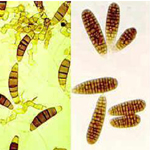 |
| Spores |
|
| Top |
| Management Strategies |
|
|
|
Preventive method
- Bacterization with Pseudomonas fluorescens reduced sheath rot severity by 20-42%, enhanced crop growth, and increased grain yield.
- Seed treatment with Bacillus subtilis @ of 10g/kg of seed followed by seedling dip @ of 2.5 kg or products/ha dissolved in 100 litres and dipping for 30 minutes.
- Soil application of P.fluorescens @ of 2.5 kg/ha after 30 days of transplanting (This product should be mixed with 50 kg of FYM/Sand and then applied.
- Foliar spray at 0.2% concentration Bacillus subtilis commencing from 45 days after transplanting at 10 days interval for 3 times depending upon the intensity of disease.
|  |
 |
| Root Dip of Seedlings with Bacillus subtilis |
Foliar Spray of Bacillus subtilis |
Cultural methods
- Removal of infected stubbles after harvest
- optimum plant spacing can reduce the disease.
- Application of potash at tillering stage is also recommended.
- Control weeds and keep field sanitation.
|
 |
 |
| Provide Optimum Plant Spacing |
Apply Potash at Tillering Stage |
Chemical methods
- For control of sheath rot, spray the fungicides at the time of panicle emergence.
- Ediphenphos may be applied by high volume sprayers only.
- Application of a systemic pesticide,Tridemorph (a fungicide) and phosphamidon (an insecticide) in combination protected the plants from sheath rot.
- Seed treatment with fungicides such as Mancozeb and Benomyl effectively eliminate seedborne inoculum.
- At booting stage, foliar spraying with carbendazim, edifenphos, or mancozeb was found to reduce sheath rot.
- Spray Carbendazim 250 g or Chlorothalonil 1 kg or Edifenphos 1 lit/ha.
- Foliar spraying with Benomyl and copper oxychloride were also found to be effective.
|
|
|
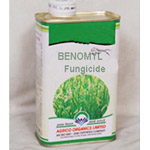 |
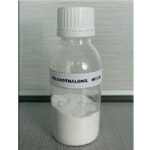 |
| Spray Benomyl |
Spray Chlorothalonil |
| |
Top |
|
